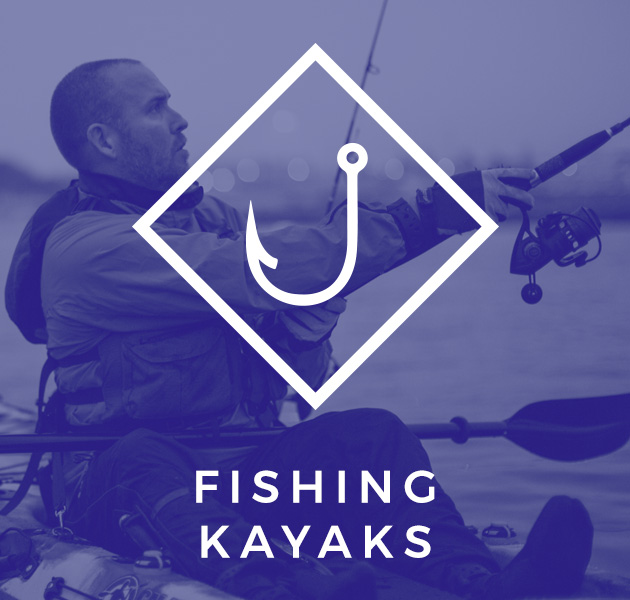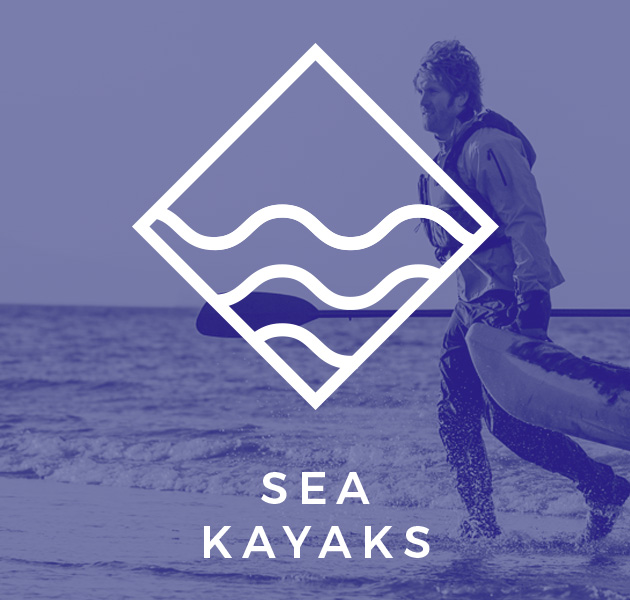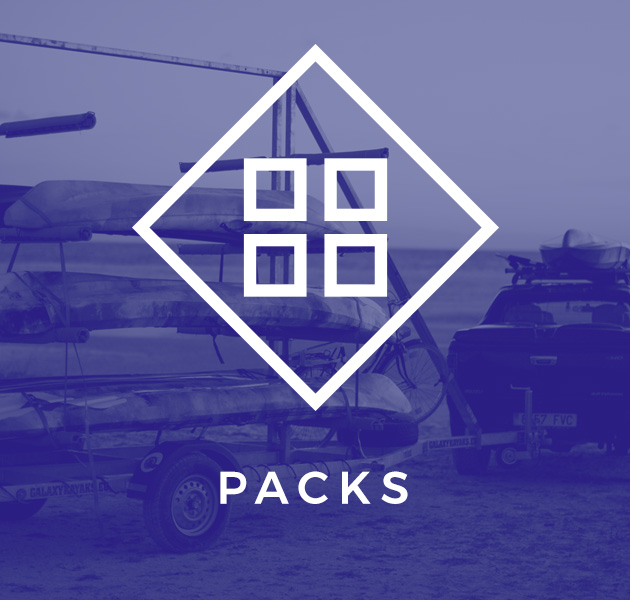Hi kayaker @ s, I'm Silvia Penadés of Team Galaxy Kayak and as a former volunteer in SALVAMENTO MARÍTIMO of Denia (LS-Diana), let's talk about maritime security. As I explained in the kayak maintenance blog, it is very important to check out our kayak, set our equipment and everything is in perfect condition before venturing into the sea.
KNOW YOUR NEW KAYAK AND YOUR LIMITATIONS WELL
If it is your first kayak, or you have just exchanged it for another model, I recommend you leave without the fishing equipment for the first contact with your new mount.
These are some things that we must take into account and know how to deal with if necessary:
- Check near the shore the tightness of all the kayak lockers.
- Practice how to recover your position in the event of a rollover, both in closed kayaks and in SIT ON TOP models and learn how to avoid filling the kayak with water when turning.Discover how your kayak reacts in cases of waves near the shore. You can find yourself in situations where the sea is good, but when the waves return it has risen and broken on the coast.
- Browse the time you think your fishing routine can be to know the speed and stability of your new kayak, as well as your own resistance.
PLAN THE DEPARTURE BEFORE LEAVING THE SEA
- If it is bad weather or you do not have it clear, do not take risks and avoid leaving.
- Study the weather and anticipate possible changes in wind and waves. It may happen that the anticipated changes are advanced and you have to leave earlier.
- Knowing the direction of the wind, you can take advantage of the drift to return more easily, so avoid your return having the wind of face
- Tell your family and friends where you are going to go out with the kayak, what time you will leave and what time you will return. If during the day there is a change of plans, communicate it.
- Avoid going out alone.
- Try to wear reflective clothes and bright colors to be visible at sea.
- Always carry the charged battery of the mobile, the VHF transmitter and the battery of the probe. Most of the probes already have GPS integrated and in case of emergency, we can give our position.
- Adjust to your measure and always check your vest so that it is in perfect condition, it is your lifeline.
- If you have rested a little, you are not used or you see that there is a bit of sea bottom, I recommend that you take biodramina half an hour before going to sea to avoid possible dizziness and that the fishing day is a disaster (consult your doctor or pharmaceutical).

ALREADY AT THE SEA
- Try to go out at least with another partner, and better in a group.
- Do not separate too much from each other and do not lose eye contact at any time
- Bring nautical whistle or horn in case it is necessary to reach out in case of emergency.
- The marine channel of the VHF station is 9, and 16 only for emergencies. You can agree on a specific channel among the partners.
- In case of emergency and you have to call by phone, the Salvage Maritime telephone number is 900 202 202. Remember also that 112 is the emergency telephone and although your company does not have coverage, if there is GSM coverage even if it is from another operator, you can call.
- Remember not to go more than 2 miles from the coast.
- Keep in mind that the kayak has a low profile and it is difficult to be seen by boats in navigation, try to go as bright as possible and I recommend bringing a mast and a flag of striking color.
- Kayaks can not navigate by law between sunset and sunrise, avoid low visibility hours.
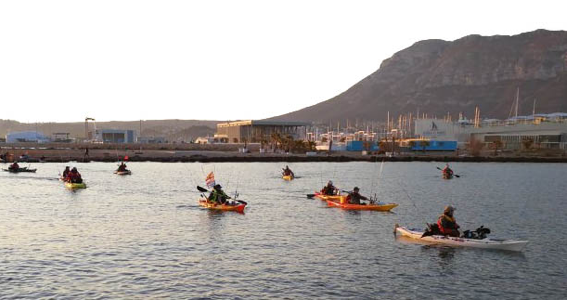
IN AN EMERGENCY SITUATION
- The first thing we have to do is alert our colleagues, and together, decide if the emergency can be solved as a team. In case you do not have an easy solution or you can put the rest of your colleagues at risk, we will ask for help by radio, telephone or if any, to a nearby boat.
- We will collect everything that could be dangerous and we will keep it, such as hooks, lures, lines, etc. This way we will avoid getting hooked and hurting ourselves and those who come to our aid.
- If the wind or tide is not conducive to return to our starting point, we will avoid overexertion and we will head to any beach or refuge that is easier for us.
- If we lose or break our means of propulsion, we will use the anchor if we are in little depth, or the anchor layer to reduce our drift.
- In case of not having a layer anchor, any rope with a sealed bag tied at one end can be used to reduce drift to a greater or lesser extent.
- We will never, under any circumstances, abandon our kayak with the intention of swimming on shore. Distances at sea always seem short and we can be fooled.
- In case of falling into the water, quickly search the kayak and try to recover the position.
- If we fall to the water and can not recover the kayak, we will avoid exhaustion and above all, we will try not to overwhelm and take off our clothes, because even wet, it can isolate us from the cold. It is not necessary to insist on the importance of the flotation aid vest or life preserver.
- If we come across a thunderstorm, we will immediately lower the rods until we even dip the dropouts in the water. Do not touch the reeds at any time.
- If we predict that the fog will come on us, we will immediately head for the coast. If the thing gets out of hand and we lose sight of the coastline, we will be guided with the GPS, with the mobile phone if we have Google Maps applications or compass applications, or with a compass like all of life. Also the breaking of the waves can guide us towards the coast. In case of listening to any boat or motor, make the greatest acoustic signals that we can to define our position.
- In case they have to help you, listen carefully to the instructions and facilitate the rescue operation as much as possible.
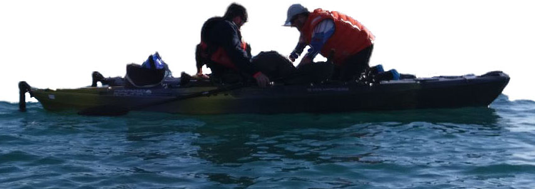
END THE FISHING DAY
When fishing is over, we are not in the habit of removing the gear until we reach the shore.
This seems irrelevant, can bring us endless dangers.
When you reach the shore, you always get up and break the wave more than on the high seas, and we run the risk of capsizing and hurting ourselves with the rigging.
In the same way, even having already descended from the kayak to make the approach to the shore, we can push a wave the kayak against us and hook us equally.
We also have to take into account that our kayaks equipped for fishing, call a lot of attention to curious, among them the smallest, and that can hurt us can put us in a very big mess.
So, I recommend that once you decide to end the fishing, pick up the gear and keep it where it can not be dangerous for the reasons explained above.
It is not necessary to remember that we will never enter the bathing area with the rigging still open. This zone is comprised between the zone marked with yellow buoys, and if there were not, an approximate distance of 200 meters from the shore.

SAFETY EQUIPMENT
Here you have a list of the recommended equipment to carry:
INDIVIDUAL AND SECURITY PROTECTION EQUIPMENT.
- Flotation or lifeguard aid vest.
- Neoprene or dry suit.
- Gloves
- Booties
- Cap or hat that covers face and neck.
- Sunglasses.
- Solar protection.
- Signal mirror
- Knife.
- Waterproof and strobe flashlight.
- Elastic cape to hold the blades.
- Line of life on each side of the kayak, from bow to stern and with handles.
- Acique and / or sponges.
- Layer or floating anchor.
- A tow line of 10 m.
- Waterproof portable VHF radio.
- Compas (compass).
- Water whistle
- Reflective bands on the deck of the kayak and paddles.
- Blanket or thermal bag
- Wear high strength tape to cover possible waterways.
- basic first aid kit.
- Drinking water at least 2 liters.
- Energy bars with high nutritional power
- Removable replacement shovel.


